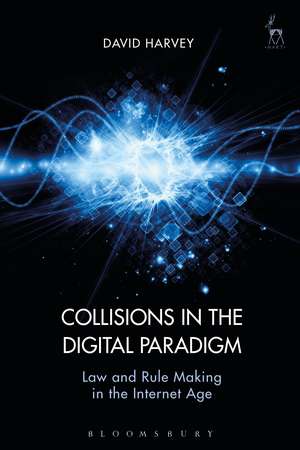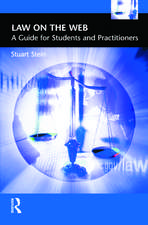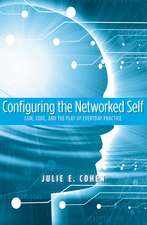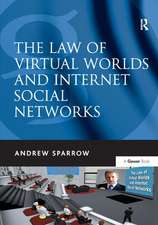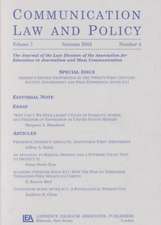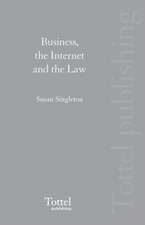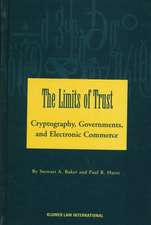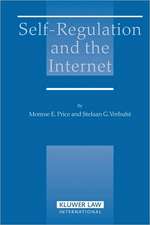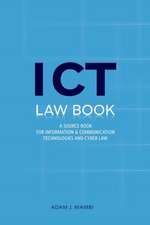Collisions in the Digital Paradigm: Law and Rule Making in the Internet Age
Autor David John Harveyen Limba Engleză Hardback – 22 mar 2017
| Toate formatele și edițiile | Preț | Express |
|---|---|---|
| Paperback (1) | 275.34 lei 6-8 săpt. | |
| Bloomsbury Publishing – 24 iul 2019 | 275.34 lei 6-8 săpt. | |
| Hardback (1) | 573.70 lei 6-8 săpt. | |
| Bloomsbury Publishing – 22 mar 2017 | 573.70 lei 6-8 săpt. |
Preț: 573.70 lei
Preț vechi: 818.81 lei
-30% Nou
Puncte Express: 861
Preț estimativ în valută:
109.79€ • 114.48$ • 91.25£
109.79€ • 114.48$ • 91.25£
Carte tipărită la comandă
Livrare economică 21 martie-04 aprilie
Preluare comenzi: 021 569.72.76
Specificații
ISBN-13: 9781509906529
ISBN-10: 1509906525
Pagini: 424
Dimensiuni: 156 x 234 x 28 mm
Greutate: 0.77 kg
Editura: Bloomsbury Publishing
Colecția Hart Publishing
Locul publicării:London, United Kingdom
ISBN-10: 1509906525
Pagini: 424
Dimensiuni: 156 x 234 x 28 mm
Greutate: 0.77 kg
Editura: Bloomsbury Publishing
Colecția Hart Publishing
Locul publicării:London, United Kingdom
Caracteristici
This book provides a critical assessment of the impact of the new technologies on lawyers and the practice of the law.
Notă biografică
David J Harvey, formerly a District Court Judge sitting in Auckland, New Zealand, is Director of the New Zealand Center for ICT Law a part-time lecturer in Law and Information Technology, both at the Faculty of Law, University of Auckland.
Cuprins
1. Introduction 2. The Analytical Framework I. Introduction II. Elizabeth Eisenstein and the Qualities of Print III. Digital Information IV. Conclusion 3. The Transition to the Digital Paradigm-Analogies and Functional Equivalence I. Introduction II. A Historical Perspective III. Digital Writing IV. Change and Communication in the Digital Paradigm V. The Law's Approach to Equating the Old with the New VI. Functional Equivalence VII. The Problem of Analogies VIII. Conclusion 4. Aspects of Internet Governance I. Introduction II. The Internet Governance Forum III. Technical Governance IV. Models of Internet Governance V. Conclusion 5. The Property Problem I. Introduction II. Information as Property-The Debate in the Digital Paradigm III. The British Commonwealth Approach IV. The United States' Position V. Property or Cyberproperty VI. Conclusion 6. Recorded Law-The Twilight of Precedent in the Digital Age I. Introduction II. Law and Precedent in the Print and Digital Paradigms III. The Twilight of Precedent? 7. Digital Information-The Nature of the Document and E-discovery I. Introduction II. The Development of E-discovery Rules III. Common Themes in the Development of E-discovery in Asia-Pacific Jurisdictions IV. The Rules and Utilisation of Technology V. Conclusion 8. Evidence, Trials, Courts and Technology I. Introduction II. Orality and Physical Presence of Witnesses III. Facing Up to Change IV. Technology in Court V. The Next Phase VI. Using Technology to Change Process Models VII. Conclusion 9. Social Media I. Introduction II. What is Social Media? III. Social Media Meets the Law IV. The Googling Juror V. Lost in Translation-Interpreting Social Media Messages VI. Other Aspects of Social Media VII. Conclusion 10. Information Persistence, Privacy and the Right to be Forgotten I. Introduction II. Privacy Themes III. Privacy Taxonomies IV. Obscurity of Information-Practical and Partial Obscurity V. Judicial Approaches VI. The Internet and Privacy VII. Search Engines and Information Retrievability VIII. The Right to be Forgotten IX. A Right to Update? X. Conclusion 11. Reputational HarmsI. Introduction II. The Publication Issue III. Google and Defamation IV. Linking and Publication V. Reputational Harms-Where Defamation Does Not Tread VI. Triaging Reputation VII. Conclusion 12. Conclusion I. The Qualities of Digital Information II. Governance of a Distributed, Dynamic, Changing Environment? III. Behavioural Change and Values IV. Old Rules in New Bottles-Seeking Consistency V. Volume, Dissemination and Availability of Information VI. Participation, Interactivity and the Message VII. Who Am I Online? VIII. The Message is the Medium-What the Law must Recognise
Recenzii
This is a good, thoughtful book, packed with balanced insights.
This book is a scholarly, fascinating, and at times uncomfortable, look at the present and the future. Based on meticulous research and in-depth knowledge, it forces you to reconsider many of your current assumptions as to what the law should do when faced with this shifting paradigm. For most lawyers, this will be a "must have" book on their shelves, as it is increasingly difficult to think of an area that is not affected by the digital world. Even if technology is not your passion, Harvey's insights are well worth the read.
Harvey's book is an authoritative text for the times. It diagnoses the challenge facing the law as we (ever so slowly) shift paradigms from print to digital, and articulates the change in thinking required to deal with the inevitable collisions accompanying the transition.
...the taxonomy provides a lucid and analytically helpful addition to the literature that will aid the reader in comprehending the implications of the digital paradigm...Harvey's appreciation for the balance between breadth and depth marks out Collisions as an excellent resource for students and practitioners seeking to gain an understanding of the main points of contention around technology, both as a discrete field of law and as a disruptor of litigation practice.
This book is a scholarly, fascinating, and at times uncomfortable, look at the present and the future. Based on meticulous research and in-depth knowledge, it forces you to reconsider many of your current assumptions as to what the law should do when faced with this shifting paradigm. For most lawyers, this will be a "must have" book on their shelves, as it is increasingly difficult to think of an area that is not affected by the digital world. Even if technology is not your passion, Harvey's insights are well worth the read.
Harvey's book is an authoritative text for the times. It diagnoses the challenge facing the law as we (ever so slowly) shift paradigms from print to digital, and articulates the change in thinking required to deal with the inevitable collisions accompanying the transition.
...the taxonomy provides a lucid and analytically helpful addition to the literature that will aid the reader in comprehending the implications of the digital paradigm...Harvey's appreciation for the balance between breadth and depth marks out Collisions as an excellent resource for students and practitioners seeking to gain an understanding of the main points of contention around technology, both as a discrete field of law and as a disruptor of litigation practice.
